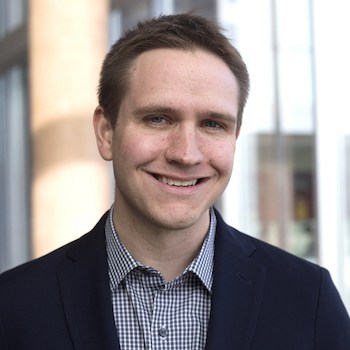
Benjamin Jorns Receives DURIP Award for Propulsion Research
Michigan Aerospace Professor Secures Defense Grant for New Equipment to Support Testing of Alternative Propellants for Next-generation in-space propulsion systems.

Michigan Aerospace Professor Secures Defense Grant for New Equipment to Support Testing of Alternative Propellants for Next-generation in-space propulsion systems.

Associate Professor Benjamin Jorns from the University of Michigan Aerospace Engineering Department has received an equipment grant from the Department of Defense as part of the Defense University Research Instrumentation Program (DURIP). The primary purpose of this grant is to enhance research efforts and purchase innovative equipment for new research capabilities.
“We are very grateful to the Air Force for this support. We are excited about the possibility of this novel pumping system for enabling new lines of inquiry into novel propellants,” commented Jorns.
Jorns leads the Plasmadynamics and Electric Propulsion Laboratory (PEPL), which focuses on advancing research in space propulsion systems, particularly Electric Propulsion (EP). One of the key requirements for the testing they conduct within the lab and the research Jorns has focused on requires the facility to recreate a space environment. To do this, the team evacuates all of the air from a vacuum chamber.
Jorns explained that while effectively achieving a vacuum is possible, running a propellant through the chamber introduces gases, compromising the vacuum environment. The challenge is then to pump that gas fast enough that the facility is still “space-like.” In most electric propulsion systems, the propellants most commonly used are noble gases like krypton and xenon. Increasingly, however, there has been a growing interest to move away from using these conventional propellants, due to their high costs and for other defense-motivated reasons. For instance, some applications call for propellants based on air or combustion products of energetic fuels.
This invites a challenge for testing: although established methods exist for pumping conventional EP gases like xenon and krypton out of the chamber, they are not optimized for more reactive gases. There are very few facilities in the world with any capacity for pumping effectively on these novel propellant combinations. This equipment grant, called “Titanium Sublimation Pumping (TSP)” is for a novel pumping scheme specifically designed to pump more reactive gases such as nitrogen and oxygen.
While TSP is not new and is widely used in other fields, it has not previously been explored at scale for EP testing. “There wasn’t a need because we weren’t using the gases that it is effective on – indeed, TSP does not even work on xenon or krypton,” explained Jorns.
Jorns and his team are confident in the capabilities of their approach to test uncommon propellants effectively. “We project that if we are successful, we will have the highest pumping speed on these gases than any facility in the world. It will position us to be able to answer ongoing research efforts that both the government and companies are looking at in the context of these other propellants: how well do thrusters run on them, are there any unforeseen issues, can we improve performance? My hope is that we will become the first stop for researchers that want to go after these questions in the context of lightweight molecular propellants with EP,” said Jorns.
The TSP system will be installed in a new, $1.3 M vacuum test chamber and building, “The Alternative Propellant Test Facility” under Jorns’ direction that was recently constructed with support from the U-M College of Engineering. This state-of-the-art facility will be pivotal for conducting groundbreaking research into novel propellants and has recently completed phase one of its two-part construction process.
For this DURIP work, Jorns is working closely with Senior Research Engineer Eric Viges, and Senior PhD student Tate Gill, who will soon be transitioning into a Research Scientist position in the Spring. Viges, the lead engineer for the new facility, leverages his expertise in large scale vacuum chamber infrastructure. While working with Jorns, Viges has overseen the preparations for the new vacuum chamber, has liaised with the College of Engineering for the renovated building that will house it, and has overseen the purchasing of key equipment to support the new facility. Viges, along with Gill, will help lead the installation of the new TSP system supported by this award.
“We’ll be designing some unique systems to go inside the vacuum chamber to be able to test these very high power hall thrusters, primarily with various alternative propellants. There will be a custom water-cooled beam dump that is being designed by me along with a unique high vacuum pump that Gill and I are working together to design and build,” Viges explained. “This unique high vacuum pump is one of the major goals of the grant. We want to be able to vacuum pump all these alternative or atypical propellants. So we are designing a unique-but-hopefully-very-effective high vacuum pump custom to fit into this chamber.”
The new vacuum chamber is being specifically designed for testing these alternative propellants as well as metals. Located right next to Jorns’ current research lab, the interior of the pre-standing building has been rebuilt to accommodate the thermal loads for their testing. The team has been working closely on the building renovation project with U-M Architecture, Engineering and Construction (AEC) to bring the labspace up to suitable standards, and update the required electrical and cooling infrastructure systems.
While quite a few other universities are looking at this type of “multi-mode operation” research, there are a handful of companies interested as well. They “broke ground” on the new facility roughly six months ago and are projected to be ready sometime in the fall of 2024. Jorns estimates at least three to four graduate students will be helping with the construction of the new facility.